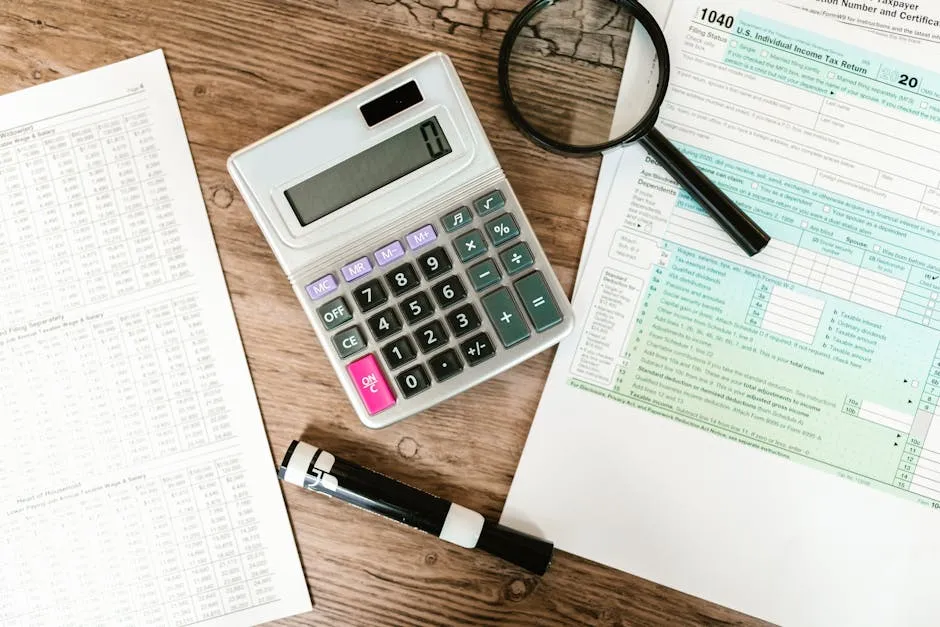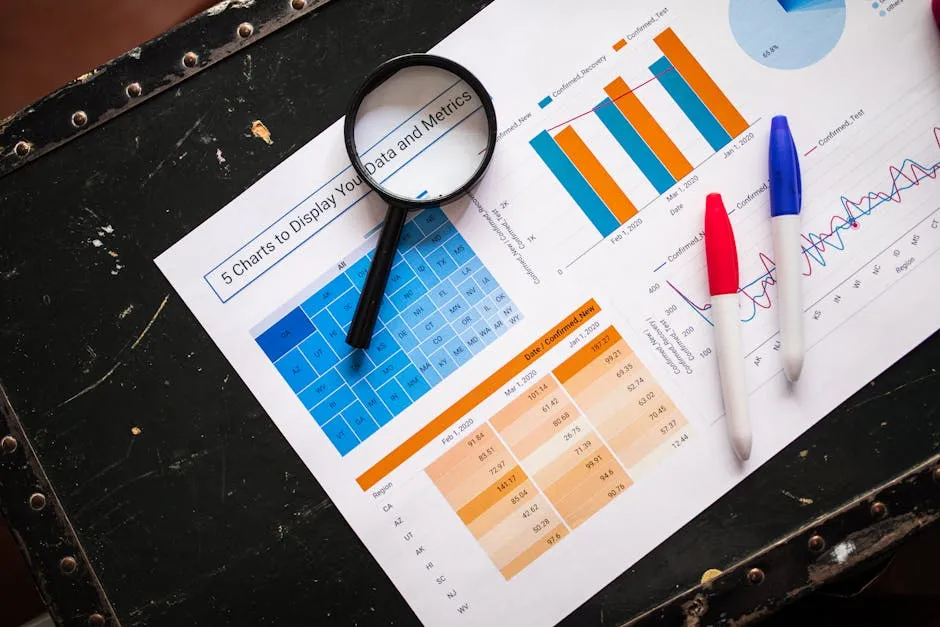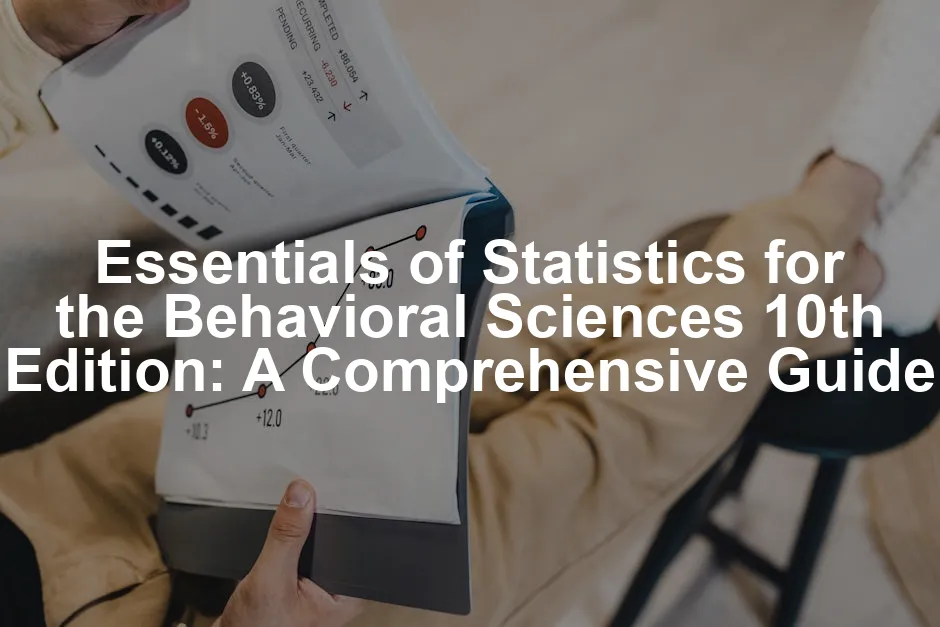Introduction
Statistics play a vital role in behavioral sciences. They help researchers make sense of data, uncover patterns, and draw meaningful conclusions. Whether it’s studying human behavior, evaluating therapy outcomes, or analyzing survey results, statistics are the backbone of scientific inquiry.
Enter “Essentials of Statistics for the Behavioral Sciences.” This textbook, now in its 10th edition, serves as a crucial resource for both students and professionals. It’s like having a personal guide through the often-intimidating world of statistics.
In this article, we’ll take an in-depth look at the latest edition of this textbook. We’ll highlight its features, delve into its relevance in current academic settings, and show why it’s an essential tool for anyone involved in behavioral research. Whether you’re a seasoned statistician or just starting to scratch the surface, this guide has something for you!

Overview of the Textbook
Authors and Publication Details
The 10th edition of “Essentials of Statistics for the Behavioral Sciences” is authored by a talented team: Frederick J. Gravetter, Larry B. Wallnau, Lori-Ann B. Forzano, and James E. Witnauer. These authors bring extensive experience and expertise in psychology and statistics to the table, making the text both reliable and engaging.
This edition was published in 2020 and is available in various formats, including paperback and eBook. The paperback ISBN is 9780357365298, while the eBook ISBN is 9780357700235. The textbook spans a substantial 608 pages, packed with illustrations, examples, and exercises designed to enhance understanding.
Designed to be accessible, the textbook is not just for the mathematically inclined. It caters to students with varying degrees of statistical knowledge, ensuring that everyone can benefit from its content. Whether you’re flipping through a print version or tapping away on an e-reader, this textbook ensures that essential statistical concepts are always at your fingertips.
If you’re looking to dive deeper into the realm of statistics, don’t forget to check out the Essentials of Statistics for the Behavioral Sciences, 10th Edition (Paperback). It’s a solid investment for anyone serious about understanding statistics in behavioral research.
The variety in formats also means that learning can happen anytime, anywhere. So, whether you prefer the traditional feel of a book or the convenience of an eBook, you’re covered! This flexibility is particularly crucial in today’s fast-paced academic landscape, where students juggle multiple commitments.

Purpose and Structure
The “Essentials of Statistics for the Behavioral Sciences” aims to demystify statistics for students. It’s not just about crunching numbers but understanding the very essence of statistical concepts that underpin behavioral research. The textbook is designed with a clear focus on how statistical methods can be used in real-world scenarios, particularly in psychology and sociology.
The structure of the book is thoughtfully laid out to guide students through the statistical landscape. It begins with foundational concepts, including an introduction to statistics and the various types of data. As the chapters progress, students encounter descriptive statistics, probability, and inferential statistics, ensuring a comprehensive understanding of essential topics. Key chapters include:
- Introduction to Statistics: Lays the groundwork for understanding data and research methodologies.
- Descriptive Statistics: Covers the tools for summarizing and organizing data effectively.
- Probability: Discusses the principles that are critical for understanding statistical inference.
- Inferential Statistics: Explains hypothesis testing and the significance of results.
- Real-World Applications: Connects statistical theory to practical use in behavioral science.
This organized approach helps build confidence in students as they navigate the complexities of statistics in behavioral sciences.

Key Features of the 10th Edition
Updated Content and Research
The 10th edition of “Essentials of Statistics for the Behavioral Sciences” is here to make your statistical nightmares vanish! It includes the latest research and up-to-date examples that reflect current trends in behavioral sciences. The authors have meticulously revised the content to address common student struggles with statistical concepts. They break down intricate ideas into digestible bits, ensuring that even those who feel mathematically challenged can grasp the material.
For instance, when discussing hypothesis testing, the text now includes clearer examples and illustrations. This helps students visualize the process and understand its application in real research situations. Plus, the new edition highlights contemporary studies, making the material relevant and engaging.
For a deeper understanding of statistical concepts, you can explore essentials of statistics for the behavioral sciences.
If you want to ensure you’re calculating everything correctly, consider investing in a reliable Scientific Calculator. It’s a game-changer for crunching those numbers with precision!

Learning Tools and Resources
This edition doesn’t just stop at traditional textbook learning. It’s packed with hands-on learning tools. The MindTap digital learning solution is a gem! Imagine having a personal tutor at your fingertips. MindTap allows students to engage with the material interactively, bridging the gap between theory and practice.
With MindTap, students can customize their learning experience. They can access interactive exercises, watch videos, and even take quizzes that reinforce their understanding. These features are particularly beneficial for those who may feel overwhelmed by statistics. By providing a variety of resources, the textbook caters to different learning styles, ensuring that every student can succeed.
Not to forget, the integrated applications throughout the book challenge students to apply what they’ve learned. This not only solidifies their understanding but also prepares them to tackle statistical problems in their future careers. So, whether you’re a visual learner or someone who thrives on hands-on practice, this textbook has got you covered!

Real-World Applications
Statistics is not just a bunch of numbers and formulas; it’s the heartbeat of behavioral sciences! Imagine a psychologist studying anxiety levels in various environments. They collect data on how patients respond in crowded places versus quiet settings. Here, statistical methods reveal the trends and patterns that help professionals understand behavior better.
Another example is in educational psychology. Researchers often analyze test scores to evaluate teaching methods. By applying statistical techniques, they can determine which methods yield the best results. This insight helps educators tailor their strategies to enhance student learning.
Understanding statistical procedures doesn’t just help researchers; it arms consumers of research with necessary skills. When reading published studies, it’s crucial to interpret the findings accurately. Without a grasp of statistics, one could easily misinterpret data or overlook important nuances. For instance, a study might show a correlation between exercise and improved mood. However, without understanding how to evaluate that correlation, one might mistakenly conclude that exercise alone causes happiness.
Statistical literacy is vital. It empowers individuals to question findings and seek clarity. In a world bombarded with information, being able to sift through data critically is more important than ever.

Chapter Breakdown
Introduction to Statistics
Statistics is the science of data. It helps behavioral scientists make sense of the vast amounts of information they collect. By defining statistics, we see its relevance in understanding human behavior and mental processes.
There are two main types of data: qualitative and quantitative. Qualitative data captures characteristics or qualities, like a participant’s opinion on a therapy style. On the other hand, quantitative data involves numbers, such as test scores or survey results.
Levels of measurement are crucial here. The nominal level classifies data without a specific order, like gender or favorite color. The ordinal level ranks data, such as satisfaction levels from a survey. Then there’s interval measurement, which involves numerical values without a true zero, like temperature. Finally, the ratio level has all the properties of interval measurement, plus a true zero, such as height or weight.
Understanding these concepts lays the foundation for the statistical procedures discussed in the textbook.

To help you with your studies, consider getting a Graphing Paper Notebook. It’s perfect for visualizing data and drawing graphs!
Descriptive Statistics
Descriptive statistics summarize data. They give us a glimpse into the big picture without overwhelming us with every single detail! Measures of central tendency include mean, median, and mode. The mean is the average score, while the median is the middle value in a dataset. The mode? That’s the most frequently occurring score.
Variability, on the other hand, tells us how spread out the data is. Key measures include range, variance, and standard deviation. For instance, a small standard deviation indicates that scores are clustered closely around the mean.
The textbook provides exercises to practice these concepts. For example, students might calculate the mean and standard deviation for a set of test scores. These exercises foster practical understanding, essential for real-world application.
For insights into how descriptive statistics are applied in manufacturing, check out descriptive statistics in manufacturing plant.

Probability
Probability is the heartbeat of inferential statistics. It helps researchers make predictions about data. Understanding the basic concepts of probability is key to interpreting research findings.
Take, for example, a drug trial. Researchers want to know the likelihood of a positive outcome with a new medication. Probability allows them to assess risks and benefits effectively. This assessment is crucial for determining the drug’s efficacy.
In research, probability also helps in sample selection. Random sampling ensures that every individual has an equal chance of being selected. This is vital for producing reliable and generalizable results.
Understanding probability is like having a secret weapon in the world of behavioral sciences. It equips researchers and consumers alike to make informed decisions based on data.
The insights and applications discussed in these chapters are just the tip of the iceberg. The textbook “Essentials of Statistics for the Behavioral Sciences” is packed with more practical examples and exercises, ensuring that readers can navigate the statistical seas with skill and confidence!

Inferential Statistics
Inferential statistics is the magic wand of data analysis. It helps researchers make predictions and decisions based on sample data. Let’s break this down into three vital components: hypothesis testing, confidence intervals, and significance testing.
Hypothesis testing is like playing detective. You start with a claim (the null hypothesis) and then gather evidence. If the evidence is strong enough, you reject the null in favor of the alternative hypothesis. Imagine you’re testing a new therapy. The null might state there’s no effect, while the alternative suggests there is. By analyzing data, you’ll determine which hypothesis holds water.
Confidence intervals come into play next. Picture this: you want a range that predicts where the true population parameter lies, based on your sample. For instance, if you’re estimating average anxiety levels after therapy, a 95% confidence interval of (20, 30) means you’re pretty darn sure the true average is somewhere in there. It’s all about giving you a cushion of certainty!
Now, significance testing adds the cherry on top. This technique helps you determine if your findings are statistically significant. A p-value less than 0.05? That’s your green light! It suggests the results are unlikely to be due to chance. It’s like discovering that your new cookie recipe is a hit, not just a happy accident.
Let’s not forget the tools we use in inferential statistics: t-tests, ANOVA, and regression analysis. T-tests compare means between two groups. For instance, you might use a t-test to see if anxiety levels differ between two therapy methods.
ANOVA, on the other hand, is the go-to when comparing three or more groups. Think of it as the referee in a game of therapy methods. It tells you if at least one group differs significantly.
Regression analysis ties everything together, helping predict outcomes based on variables. Want to know how stress predicts performance? Regression has your back!

Advanced Topics
Moving on to advanced topics, we have non-parametric statistics and multivariate techniques. Non-parametric statistics are the rebels of the stats world. They don’t rely on data following a specific distribution, making them handy when assumptions of normality are tossed out the window.
Multivariate techniques take things up a notch. They analyze multiple variables simultaneously. Think of it as a group therapy session for data. Instead of focusing on one issue, you’re addressing many, getting a holistic view of relationships between variables. It’s complex but oh-so-rewarding when uncovering insights!

Accessibility and Additional Resources
Accessibility Features
The “Essentials of Statistics for the Behavioral Sciences” textbook ensures that no student is left behind. Available in multiple formats, including PDF and EPUB, it caters to diverse learning preferences. Students can choose the format that suits them best, whether they prefer the traditional feel of a book or the convenience of an e-reader.
For students with disabilities, the textbook is designed with accessibility in mind. Features like DAISY formats enable users with print disabilities to engage with the content effectively. This ensures that all students can access vital statistical knowledge, leveling the playing field in education.

Additional Study Resources
To enhance the learning experience, the textbook comes with supplementary materials. These resources include practice exercises, quizzes, and case studies that reinforce the concepts introduced in the chapters.
Moreover, online platforms provide a treasure trove of additional study materials. Websites like Cengage and educational forums host vibrant communities where students can ask questions, share insights, and collaborate on projects.
By tapping into these resources, students not only bolster their understanding of statistics but also connect with peers, making the learning process more enriching. Embracing these tools will empower students to tackle their academic challenges with confidence and skill!

Conclusion
In conclusion, “Essentials of Statistics for the Behavioral Sciences, 10th Edition” is a powerhouse of knowledge for students and professionals alike. This textbook transforms the daunting realm of statistics into an engaging and comprehensible subject. Its authors, Gravetter, Wallnau, Forzano, and Witnauer, have crafted a resource that not only covers essential statistical concepts but also emphasizes their application in real-world behavioral science scenarios.
Throughout this article, we’ve highlighted the textbook’s key features, including its updated research, integrated learning tools, and practical applications. These elements work together to ensure that even those with minimal mathematical backgrounds can grasp complex statistical procedures. Understanding these concepts is crucial for interpreting research and becoming discerning consumers of information.
The 10th edition stands as an invaluable tool in fostering a strong foundation in statistics for students in behavioral sciences. It arms them with the skills needed to analyze data critically, conduct research effectively, and contribute meaningfully to the field.
As you embark on your academic journey, consider diving into this textbook. Whether you’re tackling statistical methods for the first time or looking to refresh your skills, “Essentials of Statistics for the Behavioral Sciences” is your ultimate companion. Embrace its resources, engage with its content, and watch your understanding of statistics soar!
FAQs
What is the focus of “Essentials of Statistics for the Behavioral Sciences”?
The textbook focuses on teaching statistical concepts and procedures relevant to psychology and research methods. It bridges the gap between theory and practice, ensuring students can apply statistics effectively in behavioral sciences.
Who are the authors of the textbook?
The authors are Frederick J. Gravetter, Larry B. Wallnau, Lori-Ann B. Forzano, and James E. Witnauer. Their collective expertise in psychology and statistics enriches the content and enhances its accessibility for students.
What are the key features of the 10th edition?
The 10th edition boasts updated research, real-world applications, and integrated learning tools like MindTap. These features ensure that students not only memorize formulas but also understand their practical implications in behavioral research.
How does the textbook support students with a weak background in mathematics?
The textbook offers comprehensive explanations and numerous learning tools designed to build confidence in statistical understanding. It uses clear, relatable examples to demystify concepts, making statistics approachable for all students.
Where can I purchase or access the textbook?
The textbook is widely available for purchase in various formats on platforms like Cengage, Amazon, and other educational retailers. Whether you prefer a paperback, an eBook, or a digital solution through MindTap, you’ll find options that suit your needs.
Please let us know what you think about our content by leaving a comment down below!
Thank you for reading till here 🙂
All images from Pexels




